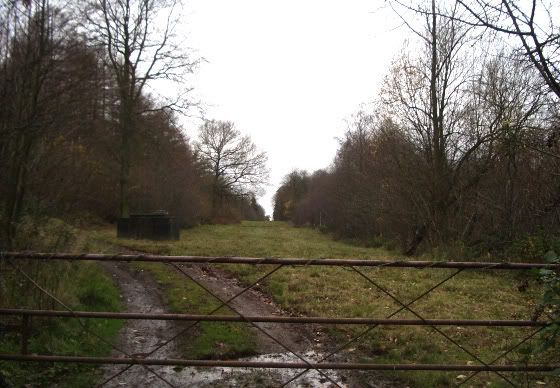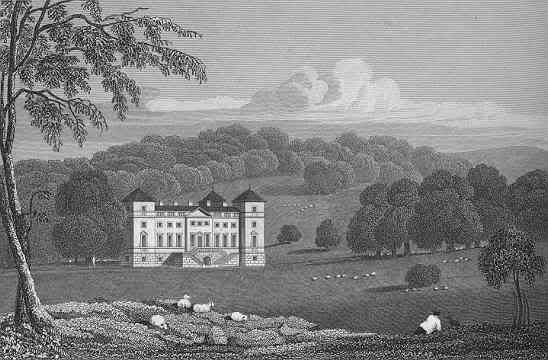Bella in the Wych Elm
 The German Spy Theory
The German Spy Theory
Another major theory, somewhat less extreme than the witchcraft explanation, and with a little more evidence to support it, emerged ten years after the discovery of the body and came in the form of a letter to the Midlands newspaper The Wolverhampton Express and Star. The letter was sent to the columnist Lt. Col. Wilfred Byford-Jones, who in November, 1953, under the pseudonym ‘Quaestor’ had written a series of articles on the Hagley Wood murder. The mysterious person who sent the letter claimed to have information about the murder and signed herself ‘ANNA, Claverley’. The basis of her story was that in 1941 a spy ring had been operating in the West Midlands, passing on information to the Luftwaffe about the location of munitions factories in the area. The organisation involved a British officer who passed on the information to a Dutch contact, who in turn gave it to a spy, a foreign trapeze artist performing at local theatres, who acted as a channel to the Germans.
The murder victim, ‘Anna’ claimed, was a Dutch woman who had arrived in England illegally about 1941 and had become involved in these activities. Apparently she had somehow learned too much about the operation and was consequently killed by the Dutchman and the trapeze artist in a car while driving through Halesowen, and then taken to nearby Hagley Wood. The letter named the British officer involved, but he was discovered to have died insane in 1942.
Eventually when Byford-Jones and the police met ‘Anna’ they learned that the officer involved had been a close relative connected to a spy-ring selling secrets to Germany. According to Byford–Jones, some of Anna’s facts were subsequently verified, and apparently both MI5 and the police investigated her claims. But the trapeze artist could not be found. Donald McCormick in his uneven book on this and another Midlands murder mystery with supposed witchcraft connections, Murder by Witchcraft, mentions that he contacted an ex-Nazi called Herr Franz Rathgeb, who had spent time in the English Midlands during the war, and knew a German agent named Lehrer who had a girlfriend also working a German spy. She was a Dutchwoman possibly called Clarabella Dronkers, who had lived in Birmingham, was about 30, and had irregular teeth. It is a known fact that a Dutchman named Johannes Marinus Dronkers was executed for spying by the British in December 1942, but whether there was ever a Clarabella Dronkers has never been proven.
Rumours that two German parachutists had landed and vanished in the Hagley area early in 1941 seemed to add more weight to the ‘spy’ theory. It all sounded somewhat promising, and when it emerged that Bella’s skeleton had disappeared from Birmingham University Medical School, cries of a cover-up at a high level were heard.
But a cover up to protect who, or why was never explained. Despite the initial promise of the theory no arrests followed and the trail seemed to lead nowhere. Perhaps the only real clues to lend any support to this theory is that the labels in Bella’s clothing had all been removed, and the complete absence of evidence for the identity of Bella in England, indicating that she may well have been a foreigner. There was also speculation that Bella may have landed in the tree hollow as a result of a parachute jump which went wrong, and was killed by the fall.
Certainly if she was discovered spying for Germany by the British she would have been arrested and questioned and not executed and stuffed in a tree.

More Theories
There were other, more down to earth, explanations for the Hagley murder mystery put forward. It was suggested that the woman had been made pregnant by a GI and taken to the woods to be disposed of there. Others proposed that she may have been a gypsy, as there was a report that at the time of the murder of gypsies camping in the area of the tree. However the police rejected this idea, partly because of her clothing, and also because while gypsies occasionally banish women from their tribes, they have never been known to murder them. Perhaps the victim was a prostitute who had been taken by car to her death in the woods? The theory was considered by the police but in the end they thought it unlikely. The explanation given most credence by the authorities at the time was also the most prosaic.They thought it most probable that the victim had been in the woods sheltering from an air raid on Birmingham, as many people fled from the city during the German bombings. Perhaps the murderer had been there for the same reason and the killing had been spur of the moment, probably during an attempted rape.
However, if Bella was a local woman sheltering from the blitz, then some clues should have turned up to her identity by now, either from relatives attempting to locate her or from relevant dental records, but nothing has ever been found, and it seems no-one knew anything about her.
The macabre tale of Bella in the wych-elm has fascinated people for many years. After reading a recent newspaper article describing the mystery, classical musician and writer Simon Holt became obsessed with Bella and was subsequently inspired to write an opera centering on the story entitled ‘Who Put Bella in the Wych Elm?’ He summed the fascination people have for the mystery thus: ‘You can put on your own angle on this story it’s so open ended – that’s why everyone likes it.’
As for the (now West Mercia ) police, while they have had various theories put forward and offers to help over the years, none have led anywhere and the identity of the victim and the killer remain unknown. In the 60 or so years since the discovery the case has remained open, and although they welcome any new leads they still refuse to allow anyone access to their files, on the grounds that the case is still unsolved.
But the mystery of Bella will not rest so lightly it seems. On 18 August, 1999, a 200 year-old stone obelisk on the Hagley Hall estate was found one morning covered in graffiti in tall white letters, ‘Who put Bella in the Witch Elm?’ it said.
The Ghost of Bella?
The main theme of Simon Holt’s ‘Who Put Bella in the Wych Elm?’ opera is the ghost of Bella returning from the beyond to tell her story. Holt’s opera was actually based on allegedly paranormal and ghostly events which occurred at the Gypsy’s Tent pub (now the Badgers Sett) near Wychbury Hill, opposite Hagley Wood. David Taylor, of UK paranormal research organisation ‘Parasearch’, remembers that when his mother worked at this pub in the late 1970s he heard many stories of the premises being haunted. Doors would open on their own, objects moved around the rooms and cold spots appeared. The staff of the Gypsy’s Tent blamed this paranormal activity on a ghost whom they called ‘Bella’, probably due to the proximity of the murder site and the mysterious nature of the girl’s death. There were, however, rumours that the real ‘Bella’ had been a barmaid in a local pub who had disappeared in the Spring of 1943, never to be seen again. David Taylor later wrote to local newspaper, ‘the Black Country Bugle ’about the ghostly incidents, and the paper subsequently published an account of the ‘Ghost of Bella’, which was to influence Simon Holt’s opera.
* Thanks to Dr J.W.G. Lund, Staff Biologist at the West Midlands Forensic Science Laboratory at the time of this case.
Additional research by Madeline Emily Croft




